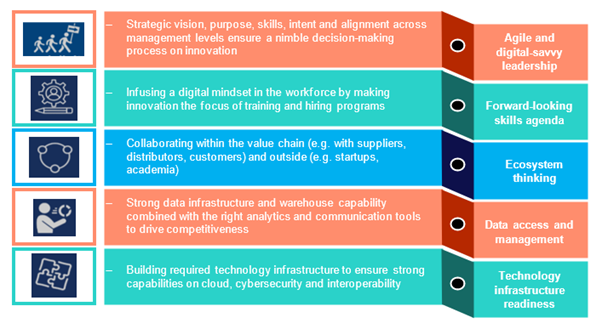Enterprises need to constantly reinvent their offerings to keep up with the rapidly evolving expectations of digital customers. Three Battlegrounds for the Digital Customer:
First Battleground: Products and services to experiences
Offering products and services is no longer the benchmark for successful companies whereas the new normal is delivering the most compelling experiences. As per World Economic Forum survey (2018-19), 56 per cent of business leaders believe that customer experience is their top digital transformation priority Companies have started on accepting this new normal i.e. digital customers are demanding high-quality experiences and guaranteed outcomes, rather than just products and services. This shift in focus is leading to new, outcome-based business models
Second Battleground: Hyper-personalisation
Customers increasingly expected relevant, personalised interactions through every engagement channel. Advances in AI and other technologies are opening up new possibilities for hyper-personalisation. Customers expect and value increasingly personalised interactions at all points of their journey, and digital technology is enabling companies to deliver such personalisation economically at scale. The challenge companies face, however, is to understand how much personalisation customers want, as 90 per cent of consumers say they would limit access to certain types of personal data
Third Battleground: Ownership to access
Access-based models enabled by digital platforms are becoming the new normal for customers as compared to ownership of goods. The global market for shared goods and services across five key sectors (Accommodation, Automotive, Construction, Luxury Apparels and Medical Equipment’s) is expected to grow to $335 billion by 2025. Companies should evaluate opportunities to cater to customer preferences for access-based models, before competitors or start-ups sweep in. This shift towards access-based consumption patterns holds important implications for businesses, especially for traditional revenue models. Ownership to access can also generate value for society. It does so by creating an economic system of marketplaces and platforms that unlock the value of underused assets and improve resource efficiency.
Key enablers for maximising the value of digital investments:

AGILE AND DIGITAL-SAVVY LEADERSHIP
Driving digital leadership across levels
Companies must make a deep cultural shift to become the disruptor, not the disruption. The best leaders recognise this and will help their workforce to understand digital change and innovate in four key areas: one, “Providing a vision and purpose”; two, “Cultivating a company-wide digital culture”; three, “Infusing a start-up mentality”; and four, “Driving efficient and transparent decision-making.”
FORWARD-LOOKING SKILLS AGENDA
Developing a digital skills agenda
Digital opportunities are linked, and their full potential can only be uncovered if people have the right skills to identify them. Getting the right people in the right place means assessing skill requirements through the lens of an overall digital vision and translating the results into a forward-looking agenda covering four key areas: one, “Re-skilling”; two, “Attracting new talent”; three, “Utilising a flexible workforce”; and four, “Building accountability.”
ECOSYSTEM THINKING
Building a digital ecosystem
As technology revolutionises how products and services are produced, distributed and consumed, visionary enterprises stretch their boundaries and tap into other digital businesses, providers, customers and competitors to create ‘digital ecosystems’ that harness ingenuity from across industries and disciplines. Using different models, they drive open collaboration with other participants in their ecosystem to make the most of data-driven opportunities.
DATA ACCESS AND MANAGEMENT
Building the foundations for data-driven efficiencies and new business models
Matching robust data infrastructure, warehousing and analytics capabilities, and strong communication tools can help companies actualise the full potential of technologies such as IoT. This is impossible without an intelligent and connected data infrastructure that helps firms keep pace with actual business requirements while allowing for potential new revenue streams.
TECHNOLOGY INFRASTRUCTURE READINESS
Fitting organisational infrastructure to technology application
New technologies rely on a set of core underlying technologies for successful implementation, e.g., IoT would not be possible without the cloud, connected devices, data management and high-speed connectivity. The right infrastructure is fundamental to scaling new technologies up and down quickly.




















Comments